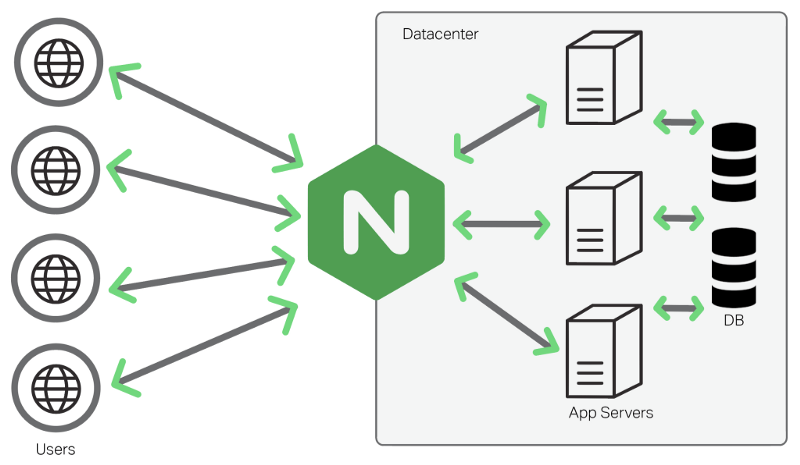Nginx Web Server
Nginx is an open-source web server that is known for its high performance, stability, rich feature set, and low resource consumption. It is used by some of the world’s top websites, including Netflix, Dropbox, and WordPress. Nginx is designed to be lightweight and efficient and can handle a wide variety of web applications from simple static web pages to complex dynamic web applications. It is highly configurable, allowing users to tweak its settings to meet their needs. Nginx is also very secure, offering various features such as access control, SSL/TLS encryption, and IP address blocking.
Overview of Nginx Web Server
Nginx (pronounced “Engine-X”) is a high-performance web and proxy server that is fast, reliable, and secure. It is used by millions of websites, including some of the most popular sites on the Internet. Nginx is open source, meaning anyone can use and modify it for free.
Nginx is designed to be used as both a web server and a reverse proxy server. As a web server, it is capable of serving static content such as HTML, CSS, JavaScript, and images as well as dynamic content such as PHP and Perl scripts. As a reverse proxy server, Nginx can be used to balance the load of multiple backend servers, and cache content, and provide additional services such as SSL encryption and authentication.
Nginx is a great alternative to Apache and other web servers due to its scalability, speed, and low resource usage. Its asynchronous event-driven architecture makes it well-suited for high-performance sites with high levels
Benefits of Using Nginx
Nginx is a powerful web server that provides many benefits over traditional web servers like Apache. Here we will discuss some of the advantages of using Nginx.
The first benefit of using Nginx is its scalability. This web server is designed to handle a large number of simultaneous connections with ease. It is also easily able to handle large volumes of traffic, making it ideal for websites and applications that experience a lot of traffic.
Another advantage of using Nginx is its performance. Nginx is known for its high performance and low resource usage. It is able to handle large numbers of requests quickly, making it ideal for sites that require fast response times.
Nginx is also very secure. It uses a number of security features to protect your website from malicious attacks. It is also very stable, meaning you can trust it to run your site without any issues.
Finally, Nginx is easy to use. It is simple to set up
3. How to Install and Configure Nginx
Nginx is a powerful and popular web server used for serving web pages and other content over the Internet. It is an open-source server and is capable of handling high amounts of traffic and load-balancing multiple servers. Here is a step-by-step guide on how to install and configure Nginx on your server.
1. First, you will need to download the latest version of Nginx from the Nginx website. Unzip the file and move it to the directory you wish to install it in.
2. Next, you will need to configure Nginx. Open the Nginx configuration file with your text editor of choice, and make any necessary changes. This includes setting up the web root directory, setting the server name, and configuring the listening port.
3. Once you have saved the configuration file, you will need to create the server block. This will define the virtual host and allow access to the web pages.
4. Finally
4. Nginx Security Features
Nginx is a powerful web server that is used by millions of websites and web applications around the world. As such, it’s important that the software is secure, and Nginx offers a number of security features that help protect your website from malicious attacks.
The first layer of protection comes from the security architecture of Nginx itself. Nginx is designed to be fast and secure, and it’s highly resistant to common web server exploits. Nginx also offers built-in access control, allowing webmasters to restrict access to certain sections of their websites.
Nginx also offers a range of features designed to protect against malicious requests. These include a Web Application Firewall (WAF), which can help protect against common web attacks such as SQL injection and cross-site scripting (XSS). Nginx also offers an SSL certificate, allowing secure communication over HTTPS and ensuring that sensitive data is encrypted. Finally, Nginx’s logging features can help identify any suspicious activity or
Nginx Performance Optimization
When it comes to website performance optimization, Nginx is an incredibly powerful tool. As one of the most popular web servers, it is widely used to deliver content-rich websites and applications with excellent speed and reliability. However, if you want to maximize the performance of your Nginx server, there are a few important steps you can take to optimize it.
The first step to Nginx performance optimization is to make sure your server has adequate memory and CPU resources. While it can run on relatively low-spec hardware, having enough resources will help ensure that your website or application responds quickly and reliably. You can also take advantage of Nginx’s built-in caching capabilities, which can help reduce load times by serving cached content instead of generating new content every time a user requests a page.
Next, you should consider using Nginx’s reverse proxy capabilities. By setting up a reverse proxy, you can route requests through multiple servers, which can help spread out the load
Troubleshooting Nginx Issues
Troubleshooting Nginx Issues can be a tricky business. While it’s a powerful and reliable web server, it can still have its share of issues. Fortunately, there are a few simple steps that can help you get to the bottom of your Nginx problems.
The first step is to check your Nginx configuration files. Take a look at your server configuration, and make sure that all of your settings are correct. If there are any typos or incorrect directives, they could be causing your problems.
Next, check your error logs. Nginx keeps detailed logs of any errors it encounters, so this can be a great way to get to the root of your issue.
If you’ve already identified the problem, then you can take a look at the documentation for Nginx. The documentation contains detailed instructions for fixing common problems.
Finally, if all else fails, you can always search for answers online. Chances are,
Q1. What is Nginx Web Server?
A1. Nginx Web Server is a popular open-source web server and reverses proxy used for hosting websites and applications. It is known for its high performance, scalability, reliability, and flexibility.
Q2. How do I install Nginx Web Server?
A2. You can install Nginx Web Server by downloading the source code, compiling it, and running the installation. Alternatively, many operating systems offer pre-compiled packages of Nginx Web Server.
Q3. What are some features of the Nginx Web Server?A3. Nginx Web Server offers a wide range of features including load balancing, caching, access control, SSL support, and HTTP/2 support. It is also highly configurable and can be used for both small and large-scale websites.
Nginx is a powerful and versatile web server that offers a wide range of features and flexibility. It is reliable, efficient, and secure. It is an excellent choice for hosting websites, web applications, and reverse proxies. It offers high performance and scalability, allowing websites to handle large amounts of traffic. Nginx is a great choice for any web server needs.







